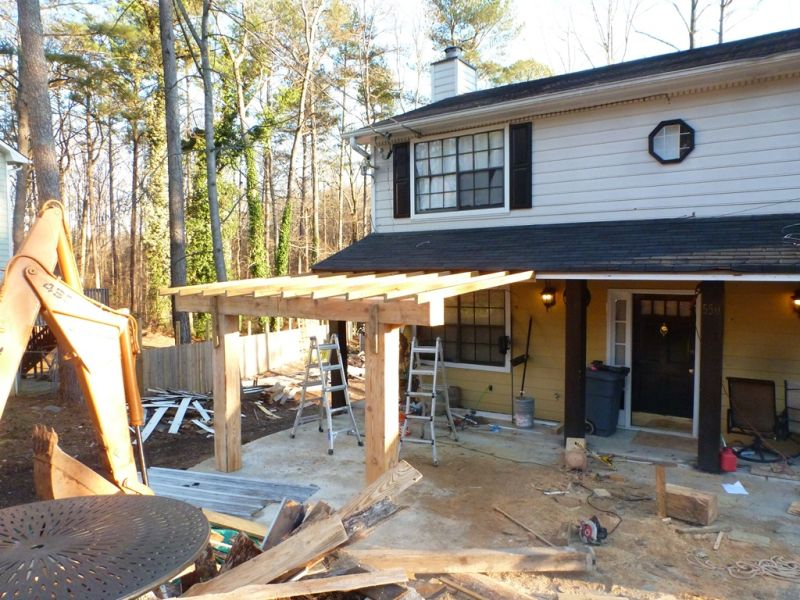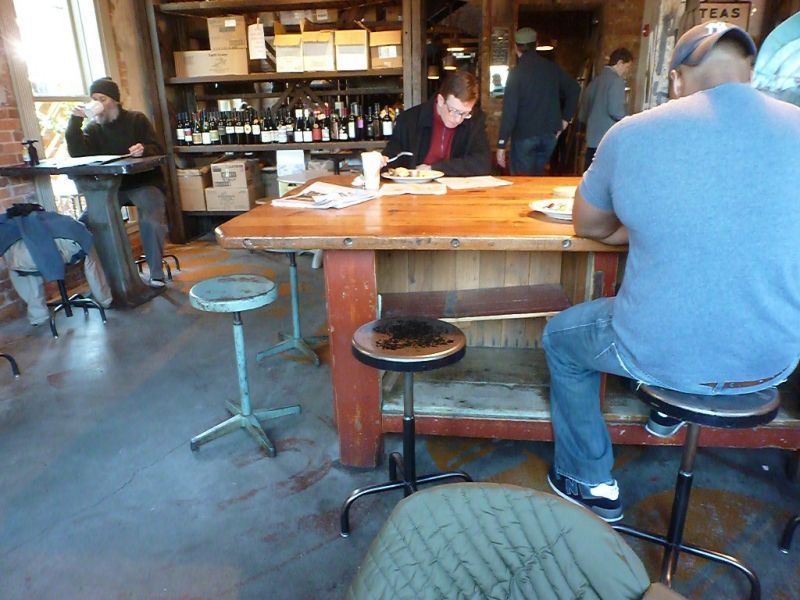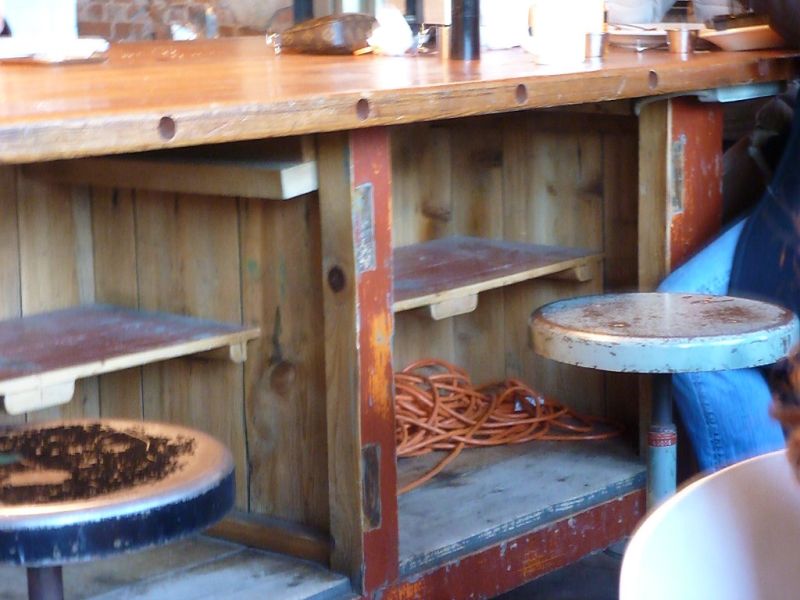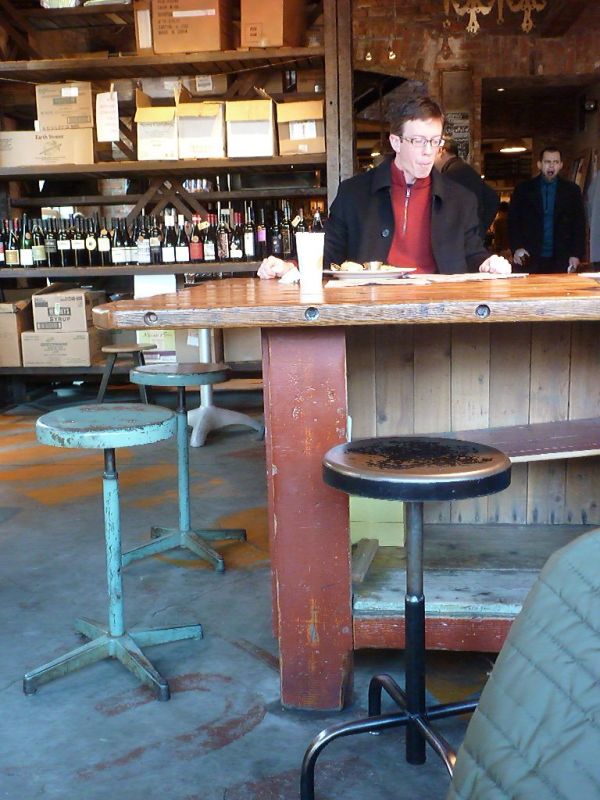From Log to Furniture
A newcomer has logs and wants to make some furniture. The sawmill forum has advice for him. January 14, 2013
Question
I am a novice when it comes to milling and post mill treatment, so please bear with me. I have a lot of SYP I have to remove from my property. This was cut abuot a year ago and has sat over a long dry summer in a pile of logs. I would really like to make use of the wood. I have a Lumbersmith Sawmill and have figured out the cutting pretty well and would now like to make something other than firewood. One of my goals is to make an old fashioned looking table similar to one in an old mill nearby. I want to use thick pieces of the pine and glue/biscuit them together to give a very solid heavy table for use in my shop. It will be about 14 feet long and I would like a bar at one end next to my fridge for the end of day refreshments.
I would like the top planks to be four inches thick and the bar to be eight inches. The legs would be probably four inches too, with open cabinets and slide out shelves. The wood is still pretty wet after sitting in log form for a year. I realize it is going to shrink some.
What would you recommend as the next steps from the freshly milled lumber? Air dry or build a kiln of some description? I have a lot more time than money, so lower cost solutions are preferred. If this comes out fairly well, I would like to take on more woodworking ventures. The finish pieces are going to be industrial grade and purposely dented, worn, and look like they have had 100 years of hard wear. I know the wood will probably continue to shrink post drying, and that is fine and will kind of work with the old fashioned, utilitarian look. Any cracks that form over time can be filled with epoxy. I just don't want it to fall apart.
Below is the result of playing with the mill and getting it set up and using a hefty patio to work under when the weather isn't great.

Click here for higher quality, full size image
Forum Responses
(Sawing and Drying Forum)
From Gene Wengert, forum technical advisor:
Any idea what it will weigh? Is the floor strong enough? Can you tolerate warping too? This is a good idea if you can dry to 20% MC first.
From contributor B:
The floor is strong enough. I am more concerned with how much warping to expect. I also need to know the best way to get the wood down to the 20% MC that you mentioned (technique, time, etc.).
From contributor J:
Iíve read some material that suggests SYP shrinkage is typically 4.4% radially and 7.7% tangential to the rings. The amount of warpage for any particular board will depend on the orientation of the rings and how close it is to the center of the tree, among other factors.
The ways you're describing your end product don't seem very consistent to me. When I think industrial, utilitarian, I picture counter-bored lag bolts and gaps and cracks that are lived with, not biscuits, glued up slabs, and epoxy-filled imperfections. If you want to end up with a smooth, flat surface without gaps between boards then you'll need to start with thoroughly dry lumber, which isn't easy to achieve with the thicknesses you're going for. If you want it to look industrial, I suggest you build it the way it would be built in an industrial setting for industrial purposes - quick, solid, and simple.
From Gene Wengert, forum technical advisor:
You can use any of the standard drying methods. Air drying will probably be easiest for you. This will achieve 20% MC. To control warping completely, dry the wood to about 10% MC using a solar kiln. The thinner the piece the more it is likely to warp. Any warp prone pieces will warp in drying and not in the table.
From the original questioner:
Contributor J - the goal is indeed to get an industrial look, which basically means I can get away with some slop and imperfections. However I would like the finished piece to be somewhat stable after construction, and minimal movement. I want the finished surface to stay flat. Below are a couple of images of the inspiration - a re-purposed table from a mill in a local restaurant to give you an idea of where I am trying to get to.
Gene - I can throw a solar kiln together. Any recommendations on dry time? We are getting 60 degree days already down here. Would adding a basement dehumidifier in the kiln provide any further benefit?

Click here for higher quality, full size image

Click here for higher quality, full size image

Click here for higher quality, full size image
From contributor J:
The top of your inspiration table is probably 2" thick, not 4". Producing a flat, stable 4" top is likely to be harder than it's worth.
From the original questioner:
I realize I am attempting double thickness. I wanted it to be more dramatic in appearance (as opposed to dramatic and falling into pieces). So should I just ditch the whole idea? No way to make it work at 4"? I don't mind a challenge, but if it realistically just isn't going to work, then I am more than willing to step back and look at other surfaces.
From contributor J:
No need to ditch the idea, but I would try to loosen my attachment to particular preconceived notions, especially the 4" solid top. That sort of thing is really difficult to achieve, which is a major reason that you almost never see such tables outside of your imagination. You can absolutely build a table that's beefy and impressive and satisfyingly industrial, but it will be a better table (and you'll have it much sooner) if you let it be a little different than you currently picture it. One solution is to make it 4" thick only at the edges and 2" or so thick the rest of the way across.
From contributor M:
I have two slabs of white pine that have been on saw benches in my shop for three years. They are close to ready for making a tabletop now. I cut table and countertop slabs at 2 1/2" this makes them thick enough to look good but still light enough to handle.
From the original questioner:
Contributor J - that's why I am posting first instead of just making myself frustrated and miserable! I did think about that suggestion of the thick edge also and am glad you also brought that up. Any suggestions on kilning and drying time?
From Gene Wengert, forum technical advisor:
Just dry it first and then it will behave fairly well. Note that white pine is nothing like SYP. Incidentally, biscuits provide little strength for a joint. Their main purpose is alignment. Whatever design you use, make sure top and bottom have the same finish, so any moisture change is uniform.
From the original questioner:
Gene - can you elaborate on what you mean by finish when you say the bottom and top should have the same finish? Are you talking about a sealer or coating?
From Gene Wengert, forum technical advisor:
If you have a ten pound of wet spy, it will have about five pounds of water. A bunch of these in a room will quickly raise the RH much higher than the dehumidifier can handle, so the rust, mold, mildew, etc. All finishes should be equal. Technically, only those finishes that change moisture (humidity) transport rates are critical, but that is likely all of them.
From contributor A:
To the original questioner: Back to your question - you stated that these logs have been felled and simply piled outside for about a year. That is around 11 months of exposure, deterioration, (rot) and insect damage. You did not state the log's diameter but I suspect that you will have to do some heavy slabbing to reach undamaged wood.
From the original questioner:
Thanks Gene - I will keep a close eye on it.
Contributor A - there is some damage from the various critters for sure. As the piece is going to be intentionally faux aged, we can turn those into a feature of the aging. I have also cut down well into the heart wood too, and then treated with a combination of borate based poison (Penetreat Disodium Octaborate Tetrahydrate) mixed with propylene glycol antifreeze (basically emulating Boracare). I think the wood will be ok from a structure point of view.
From Gene Wengert, forum technical advisor:
Do not use ethylene glycol. It is not safe. Instead, use
polyethylene glycol of at least 300, maybe 400. It is not the same as antifreeze.
From the original questioner:
You will note I did say Propylene glycol. I realize Ethylene glycol is highly toxic. However, can you clarify what you mean by 300/400 ? Why not PG antifreeze?
From contributor R:
I don't see a problem with 4" or 8" if you get it dry as Gene stated, set the pitch, make sure the critters in it are dead, finish it properly, and assemble it properly. Personally I would use splines for alignment and base finish it with shellac to help stop bleed through of the pitch. I would make sure the top was allowed to float, mounted via a slot for expansion and contraction on top of the cabinets or just centered mounting bolts. If it does move it will rip the base cabinet apart otherwise.



